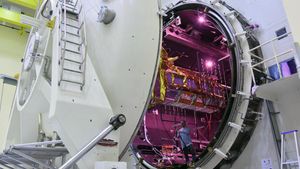JAKARTA - A report on Tuesday, November 14, said that Chinese companies continued to buy chip making equipment from the United States to produce sophisticated semiconductors, although a number of new export restrictions aimed at stopping the progress of the country's semiconductor industry.
The 741-page annual report released by the AS-China Economic and Security Commission criticizes the export restrictions imposed by the government of President Joe Biden in October 2022. The restriction aims to prevent Chinese chip-making companies from receiving US chip making equipment if the equipment will be used To produce sophisticated chips with nodes of 14 nanometers or lower.
With the Department of Trade using the 14 nanometer restriction limit, "Importers can often buy the equipment if they claim that the equipment is used in old production lines, and with a limited endless use of inspection capacity, it is difficult to verify that the equipment is not used to produce more chips Sophisticated, "said in the report.
This finding emerged when the United States tried to find out how the Chinese giant telecommunications company, Huawei, was able to produce sophisticated 7 nanometer chips to drive its Mate 60 Pro smartphone at SMIC, a leading China chip company, despite the export restrictions announced last year.
Huawei and SMIC were also added to the list of trade restrictions in 2019 and 2020, which in theory prohibited US suppliers to send certain technology to these companies.
Chinese monitors speculate that SMIC may have made chips with equipment obtained before the October 2022 rule, but the report shows that they have other options to get equipment from abroad.
The United States succeeded in closing the key gap in its efforts to stop China access to sophisticated chip making equipment by convincing Japanese and Dutch allies, which have a strong chip making equipment industry, to announce their own export restrictions on the technology sought.
اقرأ أيضا:
However, China managed to collect equipment inventory by utilizing delays between US rules in October 2022, and similar steps taken by Japan and the Netherlands in July and September 2023.
According to the document, between January and August 2023, China imported semiconductor manufacturing machines worth 3.2 billion US dollars (IDR49.6 trillion) from the Netherlands, an increase of 96.1% compared to 1.7 billion US dollars (IDR26.3 trillion) which was recorded in the same period in 2022. The import of Chinese semiconductor equipment from all countries reached 13.8 billion US dollars (R214 trillion) during the first eight months of 2023, he added.
The report does not specify special recommendations to overcome gaps in US regulations, but encourages a congress to request an annual evaluation that must be completed within 6 months by the General Accountability Firm and then published, regarding the effectiveness of export control of chip making equipment to China.
The US-China Economic and Security Commission was founded in 2000 to submit an annual report to the congress regarding the implications of national security from economic relations between the United States and China, as well as providing recommendations for government actions.
The English, Chinese, Japanese, Arabic, and French versions are automatically generated by the AI. So there may still be inaccuracies in translating, please always see Indonesian as our main language. (system supported by DigitalSiber.id)
















